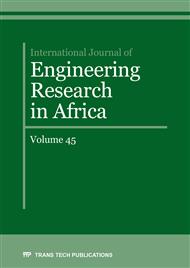[1]
F. Cassez and A. Grastien, Predictability of event occurrences in timed systems,, in International Conference on Formal Modeling and Analysis of Timed Systems, 2013, pp.62-76.
DOI: 10.1007/978-3-642-40229-6_5
Google Scholar
[2]
S. Genc and S. Lafortune, PREDICTABILITY IN DISCRETE-EVENT SYSTEMS UNDER PARTIAL OBSERVATION 1,, IFAC Proceedings Volumes, vol. 39, pp.1461-1466, (2006).
DOI: 10.3182/20060829-4-cn-2909.00243
Google Scholar
[3]
M. Sampath, R. Sengupta, S. Lafortune, K. Sinnamohideen, and D. Teneketzis, Diagnosability of discrete-event systems,, IEEE Transactions on automatic control, vol. 40, pp.1555-1575, (1995).
DOI: 10.1109/9.412626
Google Scholar
[4]
J. Saives, G. Faraut, and J.-J. Lesage, Identification of discrete event systems unobservable behaviour by petri nets using language projections,, in Control Conference (ECC), 2015 European, 2015, pp.464-471.
DOI: 10.1109/ecc.2015.7330587
Google Scholar
[5]
D. Lefebvre and C. Delherm, Diagnosis of DES with Petri net models,, Automation Science and Engineering, IEEE Transactions on, vol. 4, pp.114-118, (2007).
DOI: 10.1109/tase.2006.872122
Google Scholar
[6]
S. S. Tayarani-Bathaie, Z. S. Vanini, and K. Khorasani, Dynamic neural network-based fault diagnosis of gas turbine engines,, Neurocomputing, vol. 125, pp.153-165, (2014).
DOI: 10.1016/j.neucom.2012.06.050
Google Scholar
[7]
Y. Xu, Y. J. Chen, and Q. X. Zhu, An Extension Sample Classification‐Based Extreme Learning Machine Ensemble Method for Process Fault Diagnosis,, Chemical Engineering & Technology, vol. 37, pp.911-918, (2014).
DOI: 10.1002/ceat.201300622
Google Scholar
[8]
M. MSAAF and F. BELMAJDOUB, Fault diagnosis and prognosis in discrete event systems using statistical model and neural networks,, International Journal of Mechatronics and Automation, vol. 6, pp.173-182, (2018).
DOI: 10.1504/ijma.2018.10016612
Google Scholar
[9]
Z. Gao, C. Cecati, and S. X. Ding, A Survey of Fault Diagnosis and Fault-Tolerant Techniques—Part I: Fault Diagnosis With Model-Based and Signal-Based Approaches,, IEEE Transactions on Industrial Electronics, vol. 62, pp.3757-3767, (2015).
DOI: 10.1109/tie.2015.2417501
Google Scholar
[10]
P. Crow-AMSAA, The New Weibull Handbook,, (1993).
Google Scholar
[11]
K. Kołowrocki, Reliability of large systems,, Encyclopedia of quantitative risk analysis and assessment, vol. 4, (2008).
Google Scholar
[12]
L. Zadeh, Fuzzy Sets,, Inform Control, vol. 8, pp.338-353, (1965).
Google Scholar
[13]
S. K. De, R. Biswas, and A. R. Roy, Some operations on intuitionistic fuzzy sets,, Fuzzy Sets and Systems, vol. 114, pp.477-484, 2000/09/16/ (2000).
DOI: 10.1016/s0165-0114(98)00191-2
Google Scholar
[14]
L. A. Zadeh, A Fuzzy-Set-Theoretic Interpretation of Linguistic Hedges,, Journal of Cybernetics, vol. 2, pp.4-34, 1972/01/01 (1972).
DOI: 10.1080/01969727208542910
Google Scholar
[15]
F. Lin, Diagnosability of discrete event systems and its applications,, Discrete Event Dynamic Systems, vol. 4, pp.197-212, 1994/05/01 (1994).
DOI: 10.1007/bf01441211
Google Scholar
[16]
Z. Gao, C. Cecati, and S. X. Ding, A Survey of Fault Diagnosis and Fault-Tolerant Techniques—Part II: Fault Diagnosis With Knowledge-Based and Hybrid/Active Approaches,, IEEE Transactions on Industrial Electronics, vol. 62, pp.3768-3774, (2015).
DOI: 10.1109/tie.2015.2419013
Google Scholar


